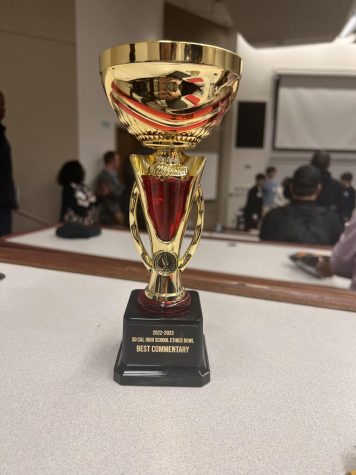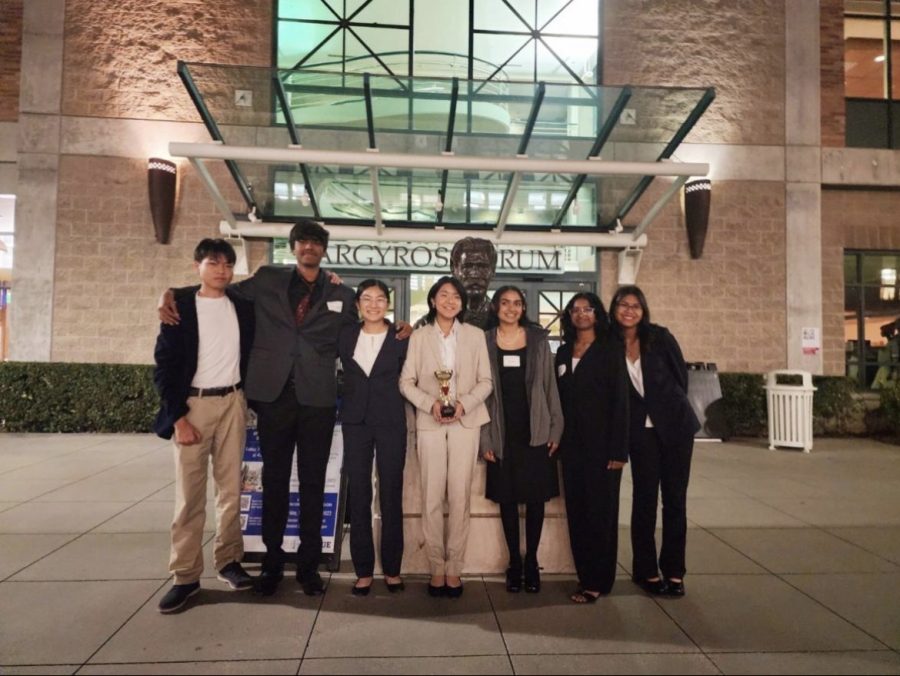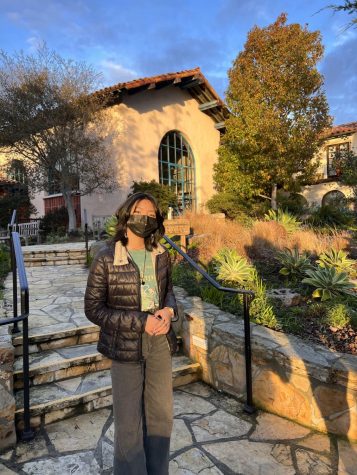ERHS Speech and Debate at SoCal Ethics Bowl
A photo of the team with their trophy taken after the awards ceremony (left to right: Derek, Tejas, Lauren, Emily, Aarohi, Saanvi, Phoebe)
February 10, 2023
What is the line between right and wrong? How do we measure it? These are the questions the ERHS Speech and Debate team faced on Feb. 4 when they attended the Southern California Ethics Bowl at Chapman University. With seven team members, Lauren Kim, Emily Wang, Derek Zhang, Aarohi Patel, Tejas Keertipati, Phoebe Heng, and Saanvi Nukala, across almost every grade, they attended the competition with just over two weeks of preperation.
In fact, Sophomore Aarohi Patel notes that the prep prior to the competition was the most stressful part. But, she also shares what made her experience worth it.
“My favorite part of Ethics Bowl was getting to debate with other schools and listening to their opinions about certain topics. It was really fun getting to have in depth conversations with other schools and thinking about things with a new mindset,” said Patel.
The National High School Ethics Bowl holds annual regional and national competitions, dedicated to promoting, “respectful, supportive, and in-depth discussion of ethics among high school students.” Founded in 2012, the Ethics Bowl has years of history, filled with collaborative discussions on complex issues, “furthering the next generation’s ability to make sound ethical decisions.”
At the competition, there are three preliminary rounds. Each team is assigned to a room and each room will consist of two teams. During the round, teams will be assigned the name of Team A or Team B, with Team A presenting first and Team B doing commentary.
Both teams are then given a case and question from the document released prior to the tournament, and Team A has three minutes of prep to answer that question with the ethical framework they had planned. After a five minute presentation, Team B is given three minutes to prepare for their commentary session. This is three minutes of comments and questions.

After that, Team A is given three minutes to prepare a three minute response, before finally having a ten minute question and answer period from the judges assigned to the room.
In addition to the experience gained by ERHS team members, they came home with the Best Commentary award out of the 18 teams in attendance, an exciting feat for Roosevelt’s second year of competition at the Southern California Ethics Bowl.
Along with the achievement of the award, the Roosevelt team did not lose a single round, going through preliminaries with two wins and one tie. While they did not advance to the semi-finals, team members share a number of positive accounts and learning curves from the competition.
Freshman Phoebe Heng shares her experience.
“The most stressful part was answering the judge’s questions. Sometimes, I didn’t know what to say and it was hard thinking and coming up with an answer,” said Heng. “If I were to compete in Ethics Bowl again, I would try to talk more and answer more questions.”
Saanvi Nukala, a Freshman, even notes how one of her favorite parts was celebrating another team member’s birthday.
At the end of the day, every member of the team agreed in sharing the spirit and excitement.
“If I was able to do anything differently, I would be less stressed about winning and doing good and just enjoy the experience,” said Patel.
If you are interested in the opportunity for experiences like the Ethics Bowl, check out ERHS Speech and Debate on Instagram @erhs.speechdebate or join their Remind @erhssd


